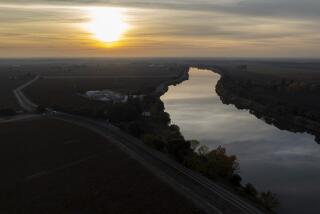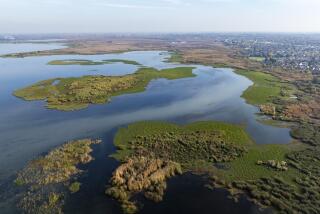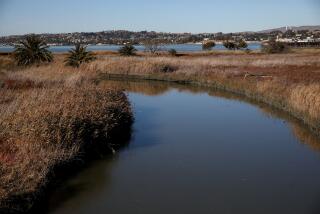Talk Flows Over Future Role of the Mississippi
- Share via
WINFIELD, Mo. — The Mississippi curls through this farm town flat and broad, a dull blue-brown conveyor belt. Corn and soybeans glide south on rust-pocked barges. Coal and fertilizer slide past them, heading north.
Folks here call it a working river.
But is it doing its job?
That question has exploded in recent weeks into furious controversy--and a potential criminal probe. The central issue: Should taxpayers invest in a $1.4-billion effort to speed commerce along the Mississippi?
To hear one side tell it, if we don’t commit the cash, we’ll soon see our highways clogged with trucks--thousands of them, grinding down our asphalt and sooting up our air as they haul commodities that once took the river route to market. Not only that: We’ll lose our competitive edge, cheap transportation, in the global market--so U.S. grain exports will plummet, socking the economy and forcing taxpayers to bail out faltering farmers.
To hear the other side talk, improving Mississippi commerce would be a colossal waste, a public subsidy of agribusiness fat cats. It also would be an environmental travesty: More barges, moving faster, would grind up more fish and churn up more silt, choking aquatic habitat. Worse, the construction would entrench our national policy of treating the Mississippi as a workhorse, not a resource, making it ever tougher to revive its onetime majesty.
To sort out these competing claims, the federal government has spent seven years--and $54 million--analyzing the costs and benefits of upgrading the 70-year-old lock-and-dam system that pushes barge traffic along the Mississippi and Illinois rivers.
Yet that study, conducted by the Army Corps of Engineers, now has come under fire.
The economist who directed the study for five years has accused the corps of fudging data to justify pricey river upgrades, including doubling the size of seven locks. After reviewing those allegations, a government investigator in February reported a “substantial likelihood” that the corps broke the law in producing its report.
Meanwhile, an environmental group has released internal corps memos that seem to undercut the agency’s pledge of unbiased analysis. “The nation is better served by [river] improvements that err on the large-scale side,” one memo read. “We have been encouraged to have our study managers not take ‘no’ for an answer,” another admonished.
The corps, which builds and operates the dams, denies wrongdoing. But its work is now under investigation by, among others, Congress, the Defense Department and the National Academy of Sciences.
And the scandal has raised new questions about the future of the Mississippi, a river of myth and might that slices through the heartland from north-central Minnesota to New Orleans, weaving past 10 states and stirring plenty of passion.
The Farmer
Eight cents.
For Iowa farmer Tim Burrack, that’s what it boils down to. That’s why Mississippi navigation must, without fail, be upgraded.
Let him explain: One afternoon last July, the corps announced it would have to slow barge traffic through one of the 29 Mississippi locks to carry out repairs. Within an hour, Burrack checked prices for the corn and soybeans he grows on his family farm.
Bids had dropped eight cents a bushel.
Anticipating delays, barges had immediately raised their shipping rates. Time is money, after all. Exporters then realized it would cost them more to bring Iowa grain downriver to the ports near New Orleans. To make up that expense, they had two options: They could charge their overseas customers more. Or they could pay their farm suppliers less.
The farmers, Burrack said bitterly, lost out.
In fact, he’s calculated that growers in Iowa alone lost $32 million in equity due to that announcement of a delay at one lock. The grain they had stockpiled for sale, in other words, was suddenly worth $32 million less.
Of course, most farmers didn’t have to sell at the reduced price. They could wait until the market rebounded when the lock was fixed two weeks later. But those with loans due had no choice but to take the eight-cent-per-bushel hit.
In that episode, Burrack sees signs of trouble ahead.
Most of the locks and dams along the Mississippi were built in the 1920s and ‘30s. They need frequent repairs. And they are not big enough to accommodate today’s mammoth tows--convoys of 15 barges lashed together. To fit through, a tow must split in half. Deckhands must untangle the cables that connect the barges, then link them up again on the other side of the lock. The whole sweaty process takes up to two hours.
Delays are inevitable. And Burrack figures it will get worse unless the locks are modernized. As traffic jams increase, those eight-cent hits will be more common. More farmers will go bust. Plus, the increased shipping cost will make American grain less competitive.
Critics argue that railroads or trucks could pick up much of the commerce now shipped along the Mississippi. But the river moves 80 million tons of goods a year, including two-thirds of all U.S. grain exports. It would take 225 rail cars--or a convoy of tractor-trailers 34 miles long--to carry the load in a single barge tow. That adds up to a lot of congestion. And without competition from barges, rail freight rates would likely spike.
Barge operators have set up a trust fund to help pay for modernizing Mississippi navigation. So if Congress OKs the project, taxpayers would pick up just half the tab.
It seems, to Burrack, an obvious call. “If U.S. agriculture in the 21st century is going to be a competitor in the global market, we do not have a choice.”
The Environmentalist
To which Carl Zichella might well reply: Hogwash.
As the Sierra Club regional director, Zichella promotes a different vision of the Mississippi--one that does not involve pouring more concrete into the river’s twisting sweep.
First, some history:
The Mississippi is navigable only because the Army Corps of Engineers has installed 29 dams between St. Paul and St. Louis. The dams divide the river into a series of pools that function like a staircase heading downriver.
Barges descend the stairs through narrow concrete chambers called locks. After a barge enters the lock, a metal gate closes behind it, sealing off the chamber. Engineers then lower the water level in the chamber until it’s even with the next pool. Then the downriver gate opens and the barge eases through.
The lock-and-dam system, which costs taxpayers $110 million a year to operate, allows the corps to control the river’s depth so barges can cruise at a steady 5 mph or 6 mph. Without the dams, the river would go wild, carving out a deep passage here, swirling around a huge sandbar there, flooding one season, drying up the next.
It’s this sass, this spirit, that Zichella longs to revive.
Untamed, the Mississippi provided vibrant habitat for fish, plants and birds. Today, however, the river is hurting. Silt churned up by the barges--and by corps dredging projects--smothers mussel beds and clouds the water, blocking light needed to nurture aquatic habitat. Tugboat propellers grind up thousands of fish on each pass through the Mississippi. The corps spends roughly $20 million a year to restore habitat that its dams have degraded.
So why, Zichella asks, keep building? He suggests solving river traffic jams with common sense, not concrete. Barge operators could, for example, coordinate their schedules so they don’t have to wait in a 10-hour line to get through a single lock. The barge industry rejects scheduling on the grounds that commodities like grain must be moved when the market beckons.
“They have some gall,” Zichella responds. “That’s the most selfish, senseless thing I’ve heard.”
The Economist
The corps’ navigation study was supposed to be a dispassionate look at this most passionate debate.
But just as the draft report was about to be submitted to Congress last month, “all hell broke loose,” spokesman Ron Fournier said.
Economist Donald C. Sweeney II filed a whistle-blower report alleging that the corps had cooked its numbers to make the case for the $1-billion-plus river upgrade.
As chief economist on the navigation study, Sweeney had concluded in 1998 that there wouldn’t be enough barge traffic to justify major improvements until at least 2020. After he made that advice public, however, he was bumped from his lead role--and corps brass ordered a new look at the numbers.
Internal memos released by the nonprofit group Environmental Defense suggest that top corps officials were casting about for a way to justify more upgrades, and sooner.
One memo put the imperative this way: If standard economic models “do not capture the need for navigation improvements, then we have to figure out some other way to do it.” Another disparaged the notion of waiting 20 years as a “limp-wristed recommendation.”
The corps eventually did come up with numbers to support major upgrades, including doubling the size of five locks on the Mississippi and perhaps two on the Illinois.
Agricultural interests applaud the corps’ revised numbers, saying the new model is more realistic than Sweeney’s because it anticipates a boom in exports and thus in barge traffic. Although grain exports have fluctuated unevenly over the last two decades--and have never come close to the exponential growth of the 1970s--agricultural groups insist trade will soar as new technology boosts U.S. harvests.
Yet some of that same technology has dragged down exports in recent years; the European Union, for example, has stopped buying U.S. corn due to fears of genetically modified seed. And with nations such as China increasingly able to feed themselves, “the bottom line is the corps’ [export] projections are grossly in error,” Iowa state economist C. Phillip Baumel contends.
The corps, however, stands by its figures.
So all sides are gearing up for a protracted battle.
Sen. Christopher S. Bond (R-Mo.) says he speaks “for the economic livelihood of the Midwest” in pleading for river improvements.
Zichella begs for restraint: “The less damage we do to the river today, the easier it will be to restore it tomorrow.”
And Christopher Brescia, who heads a barge lobby, compares today’s Mississippi to an old dirt road, utterly inadequate to serve modern commerce. If we can invest in interstate highways, he argues, surely we can invest in the Mississippi.
It is, after all, a working river.
“Some people would like the waterway system to be the way it was when Mark Twain saw it,” Brescia said. “That’s just not going to happen.”
More to Read
Sign up for Essential California
The most important California stories and recommendations in your inbox every morning.
You may occasionally receive promotional content from the Los Angeles Times.












